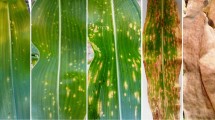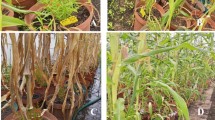Abstract
Large scale germplasm screening for Chilo partellus resistance in maize is solely based on visual scoring of damage by leaf injury rating (LIR), where the accuracy in judging a genotype comes by experience of the person, who logically integrate certain symptoms such as levels of growth retardation. Since the pest spends more than half of its larval period damaging the stalk, a quantitative phenotyping method that gives weightage to stalk resistance is required. To explore the traits governing stalk resistance, stalk infestation behaviour of C. partellus was studied first. It was found that first instar C. partellus larva is exclusive whorl feeder, second instar is the transition stage which disperse to infest stalk, and third instar onwards are exclusive stalk borers. To access the stalk, larva tends to penetrate the second above ground internode (seventh internode of maize plant) of V6–10 stage maize. Thus, penetration resistance (PR) of seventh internode was hypothesized to be the characteristic resistance trait. Twenty elite maize breeding lines were evaluated for PR of rind (RPR) and pith (PPR) of seventh internode in V6–7, V8–9 and V10–11 stage plants by TA + Di Texture Analyzer. Significant negative correlation of LIR with RPR of all plant stages and with PPR of V6–7 stage plants suggests the ability of seventh internode to resist larval penetration would confer tolerance to C. partellus. The trait was also found a strong predictor of antibiosis, by affecting the biology and behaviour of C. partellus larva. Thus, PR of seventh internode is proposed to be the trait for phenotyping stalk resistance to C. partellus in maize, whose deployment could lead to selection of genotypes which are resistant to stalk lodging also.









Similar content being viewed by others
References
Ajala, O. S., & Saxena, N. K. (1994). Interrelationship among Chilo partellus (Swinhoe) damage parameters and their contribution to grain yield reduction in maize (Zea mays L.). Applied Entomology and Zoology, 29(4), 469–476.
Bayram, A., & Tonğa, A. (2015). First report of Chilo partellus in Turkey, a new invasive maize pest for Europe. Journal of Applied Entomology, 140(3), 236–240.
Ben-Yakir, D., Chen, M., Sinev, S., & Seplyarsky, V. (2013). Chilo partellus (Swinhoe ) (Lepidoptera: Pyralidae) a new invasive species in Israel. Journal of Applied Entomology., 137(5), 398–400.
Berger, A. (1989). Ballooning activity of Chilo partellus larvae in relation to size of mother, egg batches, eggs and larvae and age of mother. Entomologia Experimentalis et Applicata, 50(2), 125–132.
Berger, A. (1992). Larval movements of Chilo partellus (Lepidoptera: Pyralidae) within and between plants: Timing, density responses and survival. Bulletin of Entomological Research, 82, 441–448.
Berger, A. (1994). Larval migration and pest management of the spotted stem-borer Chilo partellus (Swinhoe) (lepidoptera; pyralidae). International Journal of Pest Management, 40(1), 6–12.
Bosch, M., Mayer, C. D., Cookson, A., & Donnison, I. S. (2011). Identification of genes involved in cell wall biogenesis in grasses by differential gene expression profiling of elongating and non-elongating maize internodes. Journal of Experimental Botany, 62(10), 3545–3561.
Butrón, A., Malvar, R. A., Revilla, P., Soengas, P., & Ordás, A. (2002). Rind puncture resistance in maize: Inheritance and relationship with resistance to pink stem borer attack. Plant Breeding, 121, 378–382.
Calatayud, P. A., Le Ru, B. P., van den Berg, J., & Schulthess, F. (2014). Ecology of the African maize stalk borer, Busseola fusca (Lepidoptera: Noctuidae) with special reference to insect-plant interactions. Insects, 5(3), 539–563.
Calderón-Cortés, N., Quesada, M., Watanabe, H., Cano-Camacho, H., & Oyama, K. (2012). Endogenous plant cell wall digestion: A key mechanism in insect evolution. Annual Review of Ecology, Evolution, and Systematics, 43, 45–71.
Callier, V., & Nijhout, H. F. (2011). Control of body size by oxygen supply reveals size-dependent and size-independent mechanisms of molting and metamorphosis. Proceedings of the National Academy of Sciences, 108(35), 14664–14669.
Chapman, R. F., Woodhead, S., & Bernays, E. A. (1983). Survival and dispersal of young larvae of Chilo partellus (Swinhoe) (Lepi-doptera: Pyralidae) in two cultivars of sorghum. Bulletin of Entomological Research, 73(1), 65–74.
Chaudhary, R. N., & Sharma, V. K. (1989). Dispersal behaviour maize stalk-borer Chilo partellus (Swin.) in relation to spacing and orientation of rows. Journal of Insect Science, 2, 33–37.
Flint-Garcia, S. A., Darrah, L. L., McMullen, M. D., & Hibbard, B. E. (2003). Phenotypic versus marker-assisted selection for stalk strength and second-generation European corn borer resistance in maize. Theoretical and Applied Genetics, 107, 1331–1336.
Gibson, B. K., Parker, C. D., & Musser, F. R. (2010). Corn stalk penetration resistance as a predictor of southwestern corn borer (Lepidoptera: Crambidae) survival. Midsouth Entomologist, 3, 7–17.
Hu, H., Meng, Y., Wang, H., Liu, H., & Chen, S. (2012). Identifying quantitative trait loci and determining closely related stalk traits for rind penetrometer resistance in a high-oil maize population. Theoretical and Applied Genetics, 124, 1439–1447.
ICAR-IIMR (2018) Annual Report 2017–18, ICAR-Indian Institute of Maize Research, Punjab Agricultural University Campus, Ludhiana - 141004. https://iimr.icar.gov.in
Jalali, S. K., Yadavalli, L., Ojha, R., Kumar, P., Sulaikhabeevi, S. B., Sharma, R., Nair, R., Kadanur, R. C., Kamath, S. P., & Komarlingam, M. S. (2014). Baseline sensitivity of maize borers in India to the bacillus thuringiensis insecticidal proteins Cry1A.105 and Cry2Ab2. Pest Management Science. https://doi.org/10.1002/ps.3888.
Jha, S. K., Sethi, S., Srivastav, M., Dubey, A. K., Sharma, R. R., Samuel, D. V., & Singh, A. K. (2010). Firmness characteristics of mango hybrids under ambient storage. Journal of Food Engineering, 97(2), 208–212.
Jung H. J, Samac D. A, Sarath G. Modifying crops to increase cell wall digestibility (2012) Plant Sci 30(185):65–77.
Kalule, T., Ogenga-Latigo, M. W., & Okoth, V. A. (1997). Seasonal fluctuations and damage of lepidopteran stemborers of maize in a major agroecozone of Uganda. African Crop Science Journal, 5(4), 385–393.
Kfir, R., Overholt, W. A., Khan, Z. R., & Polaszek, A. (2002). Biology and management of economically important lepidopteran cereal stem borers in Africa. Annual Review of Entomology, 47, 701–731.
Kumar, H. (1988). Effect of stalk damage on growth and yield of certain maize cultivars by the maize stalk borer Chilo partellus. Entomologia experimentalis et applicata., 46(2), 149–153.
Kumar, H. (1997). Antibiosis as a resistant mechanism to Chilo partellus (Swinhoe) (Lepidoptera: Pyralidae) in selected maize genotypes. Crop Protection, 16(4), 331–336.
Kumar P, Sekhar J. C, Kaur J, Bana J. K, Suby S. B (2012) Screening techniques for maize germplasm. Technical bulletin, Directorate of Maize Research, Pusa Campus, New Delhi-110012 pp40.
Li, K., Yan, J., Li, J., & Yang, X. (2014). Genetic architecture of rind penetrometer resistance in two maize recombinant inbred line populations. BMC Plant Biology, 14(1), 152.
Martin, S. A., Darrah, L. L., & Hibbard, B. E. (2004). Divergent selection for rind penetrometer resistance and its effects on European corn borer damage and stalk traits in corn. Crop Science, 44(3), 711–717.
Martin, A. P., Palmer, W. M., Brown, C., Abel, C., Lunn, J. E., Furbank, R. T., & Grof, C. P. (2016). A developing Setaria viridis internode: An experimental system for the study of biomass generation in a C 4 model species. Biotechnology for Biofuels, 9(1), 1.
Munyiri, S. W., Mugo, S. N., Otim, M., Mwololo, J. K., & Okori, P. (2013). Mechanisms and sources of resistance in tropical maize inbred lines to Chilo partellus stem borers. The Journal of Agricultural Science, 5(7), 51.
Mzingirwa, A. M., Njoroge, P. E., Bungu, M. D., Munyinyi, D. M., & Onyango, F. O. (1994). Larval critical weight, pupation and adult fecundity in the spotted stem borer, Chilo partellus Swinhoe (Lepidoptera: Pyralidae): An index of quality. International Journal of Tropical Insect Science, 15(2), 123–127.
Pats, P., & Ekbom, B. (1992). Infestation and dispersal of early instars of Chilo partellus (Lepidoptera: Pyralidae) at different densities. Environmental Entomology, 21(5), 1110–1113.
Peiffer, J. A., Flint-Garcia, S. A., De Leon, N., McMullen, M. D., Kaeppler, S. M., & Buckler, E. S. (2013). The genetic architecture of maize stalk strength. PLoS One, 8(6), e67066.
Qi J, Malook S, Shen G, Gao L, Zhang C, Li J, Zhang J, Wang L, Wu J (2018) current understanding of maize and rice defense against insect herbivores. Plant Diversity 40 (2018) 189–95.
Santiago, R., Butrón, A., Revilla, P., & Malvar, R. A. (2011). Is the basal area of maize internodes involved in borer resistance? BMC Plant Biology, 11(1), 137.
Sarup P (1979) Investigations on major insect pests of maize with special reference to insect-plant relationship. Research bulletin of the Division of Entomology, Indian Agricultural Research Institute, New Delhi-10012 pp183.
Sibale, E., Darrah, L., & Zuber, M. (1992). Comparison of two rind penetrometers for measurement of stalk strength in maize. Maydica, 37, 111–114.
Siddiqui, K. H., Sarup, P., Panwar, V. P. S., & Marwaha, K. K. (1977). Evaluation of base ingredients to formulate artificial diets for the mass rearing of Chilo partellus (Swinhoe). Journal of Entomological Research, 1(2), 117–131.
Singh, B. U., Sharma, H. C., & Rao, K. V. (2012). Mechanisms and genetic diversity for host plant resistance to spotted stem borer, Chilo partellus in sorghum, Sorghum bicolor. Journal of Applied Entomology, 136, 386–400.
Suzuki, Y., Koyama, T., Hiruma, K., Riddiford, L. M., & Truman, J. W. (2013). A molt timer is involved in the metamorphic molt in Manduca sexta larvae. Proceedings of the National Academy of Sciences, 110(31), 12518–12525.
Tams, W. (1932). New species of African Heterocera. Entomologist, 65, 1241–1249.
Tefera, T. M., Mugo, S. N., Tende, R., & Likhayo, P. (2011). Methods of screening maize for resistance to stem borers and post-harvest insect pests (p. 44). Nairobi: CIMMYT.
Tesso, T., & Ejeta, G. (2011). Stalk strength and reaction to infection by Macrophomina phaseolina of brown midrib maize (Zea mays) and sorghum (Sorghum bicolor). Field Crops Research, 120(2), 271–275.
Van Hamburg, H. (1980). The grain-sorghum stalk-borer, Chilo partellus (Swinhoe) (Lepidoptera: Pyralidae): Survival and location of larvae at different infestation levels in plants of different ages. Journal of the Entomological Society of Southern Africa, 43(1), 71–76.
Yonow, T., Kriticos, D. J., Ota, N., Van Den Berg, J., & Hutchison, W. D. (2017). The potential global distribution of Chilo partellus, including consideration of irrigation and cropping patterns. Journal of Pest Science, 90(2), 459–477.
Acknowledgements
We acknowledge Dr. O.P. Yadav, Ex-Director, ICAR-Indian Institute of Maize Research for his advice and encouragement.
Funding
ICAR-Indian Institute of Maize Research, Project number: DMR 14:07.
Author information
Authors and Affiliations
Contributions
Conceptualization: Suby S.B.; investigation: Suby S.B., S. K. Jha, P. Kumar, J. Kaur and A. K. Cholla; data analysis: Chikkappa G. K.; resources- maintenance of maize germplasm: J. C. Sekhar and Lakshmi Soujanya P.; original draft: Suby S.B.; review and editing: P. Kumar, R.K. Sharma and S. Rakshit. All authors read and approved the manuscript.
Corresponding author
Ethics declarations
Conflict of interest
The authors declare that they have no conflict of interest.
Additional information
Publisher’s note
Springer Nature remains neutral with regard to jurisdictional claims in published maps and institutional affiliations.
Rights and permissions
About this article
Cite this article
Suby, S.B., Jha, S.K., Karjagi, C.G. et al. Penetration resistance of second above ground internode in V6–10 stage maize plants confer resistance to stalk boring larvae of Chilo partellus (Swinhoe) in maize. Phytoparasitica 48, 455–469 (2020). https://doi.org/10.1007/s12600-020-00807-6
Received:
Accepted:
Published:
Issue Date:
DOI: https://doi.org/10.1007/s12600-020-00807-6




